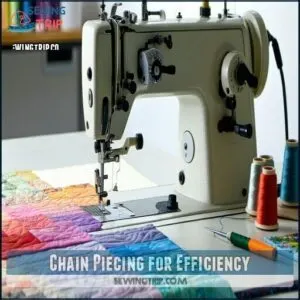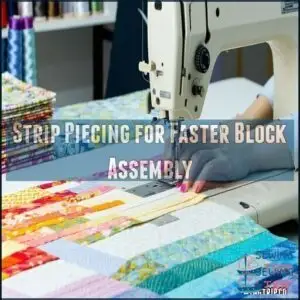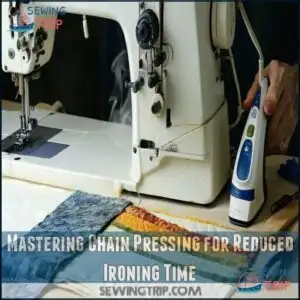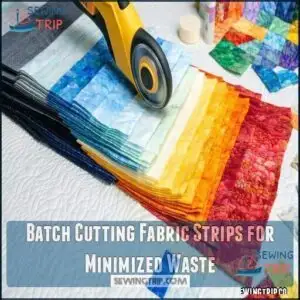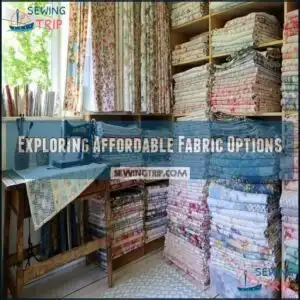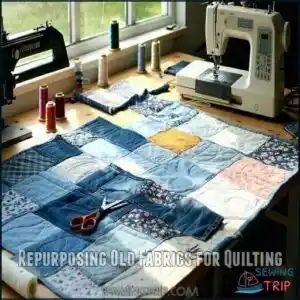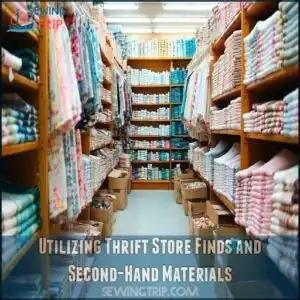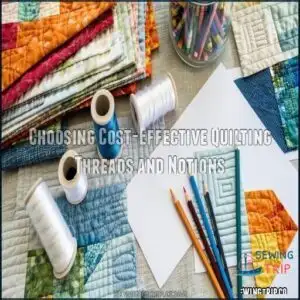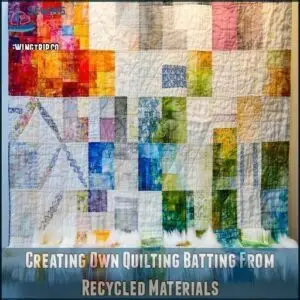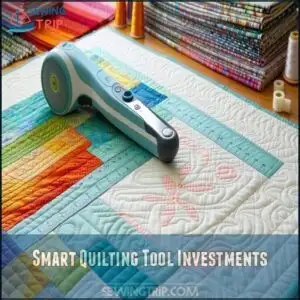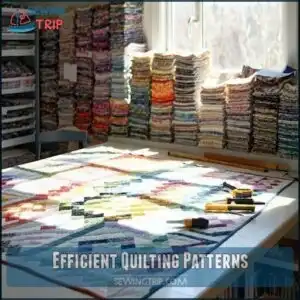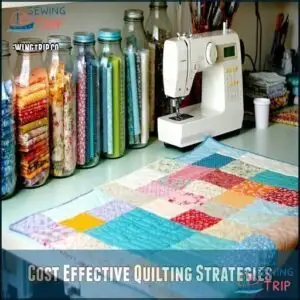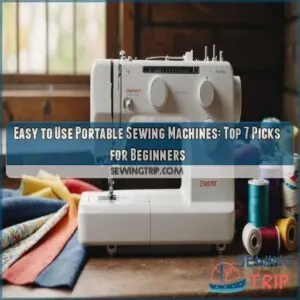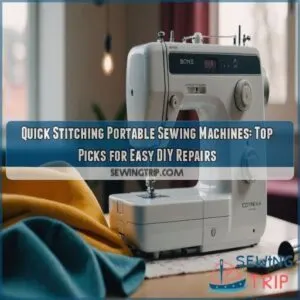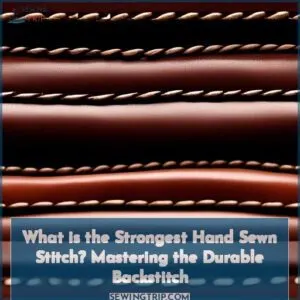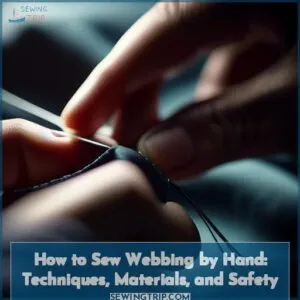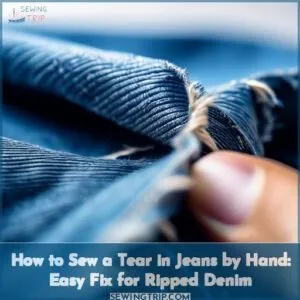This site is supported by our readers. We may earn a commission, at no cost to you, if you purchase through links.
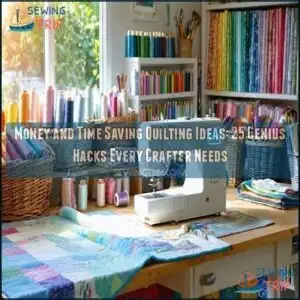 Quilting doesn’t have to cost a fortune or eat up all your free time.
Quilting doesn’t have to cost a fortune or eat up all your free time.
Start with money and time saving quilting ideas like chain piecing—it’s a game-changer for sewing blocks quickly.
Repurpose old clothes or thrifted fabrics for a unique, budget-friendly touch.
Pre-cut fabric bundles save cutting time and reduce waste, while rotary cutters make precision a breeze.
Got leftover batting scraps? Piece them together for a free quilt filler.
And don’t overlook free online patterns—they’re a goldmine!
With a little creativity and planning, you’ll stitch stunning quilts without draining your wallet or your patience, and be ready to quilt smarter.
Let’s go!
Table Of Contents
Key Takeaways
- Use chain piecing and strip piecing to sew faster and save thread while keeping your blocks consistent.
- Repurpose old clothes, thrifted fabrics, and batting scraps to cut costs and add unique touches to your quilts.
- Pre-cut fabric bundles and rotary cutters streamline cutting, reducing prep time and fabric waste.
- Explore free online patterns and tutorials for fresh ideas without spending extra on designs.
Time Saving Quilting Techniques
You’ll transform your quilting experience and reclaim your weekends with these genius time-saving techniques that experienced quilters swear by.
Reclaim your weekends and quilt smarter, not harder, with these genius time-saving techniques every quilter will love!
From chain piecing that lets you sew dozens of pieces without stopping to batch cutting that turns hours of prep into minutes, these practical shortcuts will have you finishing quilts faster.
While still maintaining that handmade quality you love, these practical shortcuts will enhance your quilting experience.
Chain Piecing for Efficiency
Chaining your way to quilting success starts with this game-changing technique.
Chain piecing lets you sew multiple blocks continuously without cutting threads between pieces.
You’ll save time, conserve thread, and maintain rhythm in your sewing.
Simply feed one block after another, creating a "chain" of pieces.
A specialized quilting tool can further streamline this process.
It’s like an assembly line for your quilting projects—efficient, fast, and surprisingly satisfying when you snip that final thread, making it a truly satisfying and efficient experience.
Strip Piecing for Faster Block Assembly
While chain piecing connects individual pieces, strip piecing takes your quilting efficiency to a whole new level!
Instead of sewing one tiny square at a time, you’ll join long fabric strips first, then cross-cut them into segments. It’s like making fabric in bulk before slicing it into perfect units.
Here’s why quilters love this technique:
- Saves 50-75% of your sewing time by reducing the number of seams
- Maintains strip width consistency across all your blocks
- Enables efficient color placement for predictable patterns
- Creates perfectly matched seams without individual pinning
You’ll be amazed how quickly those blocks stack up when you’re strip piecing!
Mastering Chain Pressing for Reduced Ironing Time
Now that you’ve mastered strip piecing, let’s tackle your ironing routine.
With chain pressing, you’ll slash your pressing time in half.
Instead of stopping to press after each seam, keep feeding those pieces through your machine and press multiple seams in one go.
This quilting shortcut dramatically improves your efficiency while reducing repetitive motion strain.
To protect delicate fabrics, consider using protective press cloths.
| Pressing Tool Choices | Best Iron Settings | Fabric Type Impact |
|---|---|---|
| Traditional Iron | Cotton: High Heat | Natural Fibers: Press Firmly |
| Mini Travel Iron | Synthetics: Medium | Delicates: Light Touch |
| Wool Pressing Mat | Delicates: Low | Dark Colors: Press Wrong Side |
| Tailor’s Clapper | Steam: On for Cotton | Directional Prints: Mind Orientation |
| Seam Roller | Dry: Best for Paper Piecing | Batiks: Less Heat Needed |
Using Rotary Cutters for Precise Cuts
Now that you’ve streamlined your pressing routine, let’s sharpen your cutting game! A rotary cutter transforms your quilting precision in seconds flat.
Keep blades sharp—dull ones drag and tear fabric. When cutting multiple layers, use firm ruler grip techniques to prevent slipping.
Always cut away from your body for safety. A rotating cutting mat lets you turn your work without disturbing fabric positioning—a real wrist-saver!
Many quilters find inspiration and purchase quilting supplies online.
Batch Cutting Fabric Strips for Minimized Waste
Now that you have a sharp rotary cutter ready, let’s maximize its potential.
Batch cutting fabric strips saves you valuable time and minimizes waste. Layer 3-4 aligned fabric pieces, then slice multiple strips at once using consistent pressure.
Cut common widths (2.5" or 1.5") for future projects. Stack fabrics light-to-dark to track color choices easily.
Remember: efficient layering techniques mean less fabric waste and more quilting on a budget, which is all about maximizing potential!
Frugal Quilting Materials
You’ll save a small fortune on your quilting passion when you start seeing potential in everything from old shirts to thrift store sheets.
Your creative eye and willingness to think outside the fabric store can transform budget-friendly finds into stunning quilts that tell unique stories.
Exploring Affordable Fabric Options
You’ll find fantastic fabric deals right around the corner at thrift stores, where quilting treasures await discovery.
Remnant bins at craft shops offer discount quilting supplies at a fraction of retail prices. Watch for budget-friendly sales during holiday weekends, and don’t forget to check online marketplaces.
Fabric swaps with fellow quilters refresh your stash without spending a dime. Sign up for store newsletters to catch flash sales on affordable quilting fabrics.
Consider upcycled linens for unique, cost-effective options.
Repurposing Old Fabrics for Quilting
Beyond bargain fabric shopping, your closet holds textile treasures waiting for a second life.
Turn those old jeans into stunning denim quilts or transform worn shirts into memory blocks.
Those faded bedsheet quilts often become family favorites!
Don’t toss tiny fabric scraps – they’re perfect for pincushions or pet beds.
Even batting scraps can be stitched together for "frankenbatting."
Your trash truly becomes quilting treasure with these **upcycled fabric quilts.
Utilizing Thrift Store Finds and Second-Hand Materials
Behind the doors of thrift stores lies a goldmine of quilting materials waiting to be discovered.
With a keen eye, you’ll transform second-hand treasures into stunning quilts while saving serious cash.
Vintage textile treasures often cost pennies compared to craft store prices.
- Score vintage bedsheets with beautiful patterns that provide yards of fabric for under $5
- Transform those abandoned dress shirts into memory quilts that tell stories with every stitch
- Discover forgotten embellishments like buttons and lace that add character your competitors can’t buy
Choosing Cost-Effective Quilting Threads and Notions
While quilting can drain your wallet faster than a leaky faucet, smart choices in threads and notions will keep your budget intact.
Stick with basic thread materials like cotton for piecing and polyester for quilting.
Invest in quality needle types that last longer, and grab seam rippers from dollar stores.
Use chalk as marking tools instead of fancy pens, and try school glue as affordable alternatives to specialty adhesives.
Many quilters find success with economical thread options.
Creating Own Quilting Batting From Recycled Materials
Crafty quilters don’t need to break the bank on batting. You can create your own quilting batting from recycled materials like plastic water bottles, thread scraps, or fabric leftovers.
Layer thread tails between silk organza for unique texture, or piece together batting scraps for zero waste.
Control batting density by adjusting your material layers.
For long-term durability, secure recycled batting with closer stitching patterns.
Smart Quilting Tool Investments
You’ll save both time and money by investing in the right quilting tools, rather than buying every gadget that catches your eye.
A good rotary cutter, self-healing mat, and quality rulers will become your best quilting buddies, paying for themselves many times over as you whip through projects without the frustration of dull blades or wobbly measurements.
This approach allows you to work efficiently, making the most of your quilting efforts, and ensuring that each project turns out as envisioned, with precision and care.
Essential Quilting Tools for Beginners on Budget
While repurposing fabrics opens creative doors, you’ll still need some basic tools to start quilting without breaking the bank.
Start with just five budget essentials: a reliable basic sewing machine, an affordable cutting mat, budget rotary cutter, two basic quilting rulers (6"x24" and square), and a thrifty seam ripper.
Using tailor’s chalk can help mark your fabric precisely before cutting.
These low-cost quilting fundamentals will carry you through countless beginner quilting projects before you need anything fancier, making it a great way to explore quilting and sewing without significant investment.
Investing in Time-Saving Quilting Machines and Gadgets
While building your basic toolkit is step one, strategic machine investments can truly revolutionize your quilting time.
The AccuQuilt GO! fabric cutter slashes cutting time by 90%, handling up to six fabric layers simultaneously.
For around $330, it’s a splurge that quickly pays off by reducing hand strain and improving accuracy, making these cutting machines timesaving quilting powerhouses that transform how efficiently you create, and they’re not just convenient gadgets—they’re essential for improving your overall quilting experience with cutting machines.
Using Technology to Enhance Quilting Efficiency
Just as smart investment choices boost your quilting game, modern technology opens new doors for efficiency.
With WiFi-connected smart sewing machines, you’ll tap into mySewnet cloud storage and automatic updates.
Your digital pattern designs load directly to your machine, while the generous 12" workspace lets you tackle quilts with ease.
Innovative lighting technology illuminates your work evenly, reducing eye strain during those late-night quilting sessions.
These tech-forward quilting hacks streamline your process while helping you create precise, beautiful results, making them a great addition to your quilting game.
Choosing Right Quilting Needles and Threads
The right needle and thread combination can make or break your quilting project.
Choose sharper needles (70/10 or 80/12) for piecing and sturdier ones (90/14) for quilting through layers. Stick with 50-weight cotton thread for piecing—it’s your quilting BFF!
For specialty work, splurge only when necessary. Remember, proper thread tension saves both money and headaches in the long run, and it’s a key part of having the right needle.
DIY Quilting Tools and Accessories for Frugal Quilters
You don’t need to shell out big bucks for fancy quilting equipment.
Create homemade rulers from clear plastic packaging, transform old pencils into upcycled seam rippers, and make a DIY lightbox using a clear storage bin and LED lights.
Simple ironing board hacks like adding a shelf underneath maximize space, while empty mint tins make perfect needle storage.
Quilting on a budget becomes easier with these cheap quilting projects and tips.
Efficient Quilting Patterns
You’ll save countless hours and dollars by choosing the right quilting patterns for your projects.
Smart pattern selection means you can finish that quilt before the baby shower actually happens, instead of presenting it at their college graduation!
Creating Simple and Quick Quilting Patterns
Sometimes the simplest quilt becomes your fastest finish!
The simplest quilts often bring the quickest joy, proving that beauty doesn’t have to take forever.
Large Block Quilts cut your sewing time in half while creating bold visual impact.
For quilting shortcuts that won’t sacrifice style, try Minimal Seam Quilts like rail fence or disappearing nine-patch.
Beginner Friendly Designs often make the best Quick Finish Projects—you’ll be snuggled under your masterpiece before you know it.
Easy quilt patterns aren’t just for quilting for beginners; they’re for anyone racing against the clock to create something with minimal effort!
Using Pre-Cut Fabric Bundles for Efficient Quilting
The convenience of pre-cut fabric bundles can revolutionize your quilting projects.
These ready-to-use collections offer significant time savings by eliminating hours of cutting.
You’ll reduce waste while enjoying perfectly coordinated designs—ideal for quilting on a budget.
Choose between jelly rolls, charm packs, or layer cakes based on your pattern needs.
They’re perfect for beginners seeking quilting shortcuts or experienced crafters wanting fast quilting ideas without sacrificing style.
Mastering One-Block Wonders for Time-Saving
While many quilting projects can take weeks to complete, One-Block Wonders offer a fast track to stunning results with minimal seam matching.
These kaleidoscopic quilts transform identical fabric strips into eye-catching designs through efficient cutting methods.
Try these timesaving approaches:
- Select bold, large-scale prints for dramatic design variations
- Cut multiple fabric layers simultaneously for cutting efficiency
- Chain piece hexagons in rows for quicker assembly
You’ll create showstopping quilts in half the time!
Utilizing Free Quilting Patterns and Tutorials Online
Free quilting patterns and tutorials are a goldmine for every skill level.
Websites like Amy’s blog and Quilt Circle offer accessible designs, from beginner-friendly scrappy looks to intricate gingham quilts.
These resources save money and inspire creativity. Fat Quarter Shop provides printable pattern designs suitable for all skill levels.
Just remember, copyright issues matter—share responsibly and respect creators. Bonus tip: online communities make quilting even more rewarding!
Designing Quilts With Time-Saving Techniques in Mind
Efficient layouts and simplified patterns are your best friends for quick quilt finishes.
Try these thrifty quilting tips:
- Use modular designs for simple quilt designs that come together fast.
- Stick to minimalist quilting for a clean, budget-friendly look.
Choose precut-friendly patterns to save time cutting fabric.
Plan quilts with quilting on a budget in mind—your stash is gold!
Cost Effective Quilting Strategies
You don’t need to spend a fortune to create stunning quilts that tell a story.
With a little creativity and some clever repurposing, you can turn forgotten fabrics and household items into masterpieces.
While keeping your wallet happy, you can achieve this by being mindful of your expenses and resources.
Shopping Stash Before Buying New Materials
Before grabbing your wallet, peek into your fabric stash.
Organizing it can spark ideas for scrap fabric quilts or reveal hidden gems perfect for quilting on a budget.
Keep a fabric inventory to avoid buying duplicates and reduce impulse buys.
Creative stash use saves money and also makes project planning feel like treasure hunting! It is a way to use your resources efficiently, and by doing so, you can make the most out of your fabric stash.
Using Household Items for Quilting Projects
Look around your home—hidden quilting treasures are everywhere!
- Fabric Softener Sheets: Perfect for stabilizing delicate fabrics or adding a soft touch to your quilt layers.
- Cereal Box Templates: Cut them into reusable shapes for precise quilting patterns.
- Shower Curtain Rulers: Repurpose old ones as oversized rulers or cutting guides.
Get creative, and your quilting projects will thank you!
Repurposing Clothing and Fabrics From Closets
Closet mining turns forgotten fabrics into quilting treasures.
Old jeans? Perfect for sturdy blocks.
Worn-out shirts? Great for soft, colorful squares.
Textile upcycling saves money and adds charm to your quilts.
Plus, every stitch tells a story!
| Clothing Transformations | Fabric Reclamation | Material Revival |
|---|---|---|
| Jeans to quilt blocks | Shirts to squares | Scarves to accents |
| Dresses to backings | Skirts to strips | Ties to patterns |
Saving and Piecing Together Batting Scraps
Don’t toss those batting scraps—they’re gold for budget-friendly quilting.
Piece them together using zigzag or butt seams for smooth, durable joins.
Keep density consistent to avoid lumpy quilts, especially for longarm quilting.
Match batting seam types to your quilt size for best results.
For smaller projects, consider using them to create scrappy fabric garlands.
- Use fusible tape for easy joining.
- Trim edges for clean seams.
- Overlap slightly for stability.
- Store scraps by size for stash busting.
Utilizing Leftover Fabrics for Quilt Backings
After piecing batting scraps, turn to your fabric stash for backings.
Scrap size matters—combine larger pieces with smart piecing techniques for seamless results.
Focus on color coordination and design considerations to avoid mismatched chaos.
Quilting with scraps isn’t just thrifty; it’s creative stash busting.
Recycled fabric quilting adds charm while reducing fabric waste.
Plus, backing durability guarantees quilts last.
Frequently Asked Questions (FAQs)
How can I save money on quilting?
Think of your stash as buried treasure—shop it first!
Upcycle old clothes or sheets, snag thrift store finds, and hunt sales.
Skip fancy tools early on; basics like washi tape work wonders for quilting!
What is the golden rule in quilting?
The golden rule in quilting? Measure twice, cut once.
It saves you from fabric disasters and heartache.
Precision is key—your quilt’s beauty depends on those cuts and seams lining up like a dream!
What is the greatest investment in quilting?
Imagine discovering a high-quality sewing machine at half the price—it’s game-changing!
Your greatest investment is quality tools.
Great scissors, rulers, and machines save time, reduce frustration, and make quilting a joy—not a chore.
How much does an average quilter spend per year?
You’ll likely spend $500 to $1,000 annually on quilting, depending on fabric choices, tools, and project sizes.
Thrift finds, sales, and using your stash can stretch your dollars while fueling your creativity.
What is the trend in quilting in 2024?
Quilting in 2024 feels like patching stories together—sustainability shines, with upcycled fabrics and stash projects taking center stage.
You’ll see bold, modern designs, scrappy quilts, and a love for community-driven quilting swaps and collaborations.
How to organize quilting supplies for efficiency?
Keep supplies tidy by sorting fabric by color or size, storing tools in labeled bins, and using pegboards for easy access.
Keep a notebook handy for project notes—it’s like a brain backup for your creativity!
What are best sources for secondhand quilting fabrics?
Check thrift stores, estate sales, and fabric swaps for affordable secondhand materials.
Dig through remnant bins or browse Facebook Marketplace for hidden gems.
Even old clothes, like denim or vintage tees, can make quirky quilt blocks, and this can be a great way to create something new from secondhand materials.
How can fabric storage reduce quilting costs?
Picture tidy shelves with neatly folded fabrics—no more hunting for lost pieces or buying extras.
Organized storage saves cash by preventing duplicates, preserving fabric quality, and turning scraps into treasures for new projects.
Tips for maximizing quilt backing material efficiency?
Think outside the box—piece together smaller fabric scraps for the backing, or sew strips for a unique design.
Measure carefully, and don’t forget, old sheets or large thrifted fabrics make great budget-friendly options!
Ways to minimize electricity usage while quilting?
Did you know sewing machines use about 100 watts per hour?
Unplug when not sewing, use LED task lights, and batch tasks like cutting or pressing to reduce runtime.
Your wallet—and planet—will thank you!
Conclusion
Imagine this: you’ve just finished a quilt using thrifted fabric and leftover batting scraps, and it looks amazing.
With these money and time saving quilting ideas, you can create stunning projects without overspending or stressing.
Chain piecing speeds up your sewing, while free online patterns spark creativity.
Repurposing old clothes adds charm, and pre-cut bundles save effort.
Quilting smarter isn’t just possible—it’s fun and rewarding.
So grab your tools, start stitching, and enjoy the process!
- https://www.accuquilt.com/blog/quilting-on-a-budget-tips-your-pocket-will-love?srsltid=AfmBOopl_gELvwpRy7Zb20eKMgpx5ke8SuRJ9kFc152ohBjZptFOT__o
- https://villarosaquilts.com/2024/09/05/quilting-on-a-budget-thrifty-tips-and-tricks-for-fabulous-frugal-quilts/
- https://www.createwithclaudia.com/2021/02/quilting-on-a-budget/
- https://quiltingrebel.com/save-money-on-quilting/
- https://nomadicquilter.com/blogs/blog/how-to-save-money-on-backing-fabric?srsltid=AfmBOoqFSfciF0DVPEGFaiZ8EhyIVLAc-FxkhNxr4J4SmeGEs4fVBJHA

